Target Information
| Target General Information | Top | |||||
|---|---|---|---|---|---|---|
| Target ID |
T26457
(Former ID: TTDI02427)
|
|||||
| Target Name |
Integrin beta-3 (ITGB3)
|
|||||
| Synonyms |
GPIIIa; GP3A; CD61
Click to Show/Hide
|
|||||
| Gene Name |
ITGB3
|
|||||
| Target Type |
Literature-reported target
|
[1] | ||||
| Function |
Integrin alpha-IIb/beta-3 (ITGA2B:ITGB3) is a receptor for fibronectin, fibrinogen, plasminogen, prothrombin, thrombospondin and vitronectin. Integrins alpha-IIb/beta-3 and alpha-V/beta-3 recognize the sequence R-G-D in a wide array of ligands. Integrin alpha-IIb/beta-3 recognizes the sequence H-H-L-G-G-G-A-K-Q-A-G-D-V in fibrinogen gamma chain. Following activation integrin alpha-IIb/beta-3 brings about platelet/platelet interaction through binding of soluble fibrinogen. This step leads to rapid platelet aggregation which physically plugs ruptured endothelial surface. Fibrinogen binding enhances SELP expression in activated platelets. ITGAV:ITGB3 binds to fractalkine (CX3CL1) and acts as its coreceptor in CX3CR1-dependent fractalkine signaling. ITGAV:ITGB3 binds to NRG1 (via EGF domain) and this binding is essential for NRG1-ERBB signaling. ITGAV:ITGB3 binds to FGF1 and this binding is essential for FGF1 signaling. ITGAV:ITGB3 binds to FGF2 and this binding is essential for FGF2 signaling. ITGAV:ITGB3 binds to IGF1 and this binding is essential for IGF1 signaling. ITGAV:ITGB3 binds to IGF2 and this binding is essential for IGF2 signaling. ITGAV:ITGB3 binds to IL1B and this binding is essential for IL1B signaling. ITGAV:ITGB3 binds to PLA2G2A via a site (site 2) which is distinct from the classical ligand-binding site (site 1) and this induces integrin conformational changes and enhanced ligand binding to site 1. ITGAV:ITGB3 acts as a receptor for fibrillin-1 (FBN1) and mediates R-G-D-dependent cell adhesion to FBN1. Integrin alpha-V/beta-3 (ITGAV:ITGB3) is a receptor for cytotactin, fibronectin, laminin, matrix metalloproteinase-2, osteopontin, osteomodulin, prothrombin, thrombospondin, vitronectin and von Willebrand factor.
Click to Show/Hide
|
|||||
| BioChemical Class |
Integrin
|
|||||
| UniProt ID | ||||||
| Sequence |
MRARPRPRPLWATVLALGALAGVGVGGPNICTTRGVSSCQQCLAVSPMCAWCSDEALPLG
SPRCDLKENLLKDNCAPESIEFPVSEARVLEDRPLSDKGSGDSSQVTQVSPQRIALRLRP DDSKNFSIQVRQVEDYPVDIYYLMDLSYSMKDDLWSIQNLGTKLATQMRKLTSNLRIGFG AFVDKPVSPYMYISPPEALENPCYDMKTTCLPMFGYKHVLTLTDQVTRFNEEVKKQSVSR NRDAPEGGFDAIMQATVCDEKIGWRNDASHLLVFTTDAKTHIALDGRLAGIVQPNDGQCH VGSDNHYSASTTMDYPSLGLMTEKLSQKNINLIFAVTENVVNLYQNYSELIPGTTVGVLS MDSSNVLQLIVDAYGKIRSKVELEVRDLPEELSLSFNATCLNNEVIPGLKSCMGLKIGDT VSFSIEAKVRGCPQEKEKSFTIKPVGFKDSLIVQVTFDCDCACQAQAEPNSHRCNNGNGT FECGVCRCGPGWLGSQCECSEEDYRPSQQDECSPREGQPVCSQRGECLCGQCVCHSSDFG KITGKYCECDDFSCVRYKGEMCSGHGQCSCGDCLCDSDWTGYYCNCTTRTDTCMSSNGLL CSGRGKCECGSCVCIQPGSYGDTCEKCPTCPDACTFKKECVECKKFDRGALHDENTCNRY CRDEIESVKELKDTGKDAVNCTYKNEDDCVVRFQYYEDSSGKSILYVVEEPECPKGPDIL VVLLSVMGAILLIGLAALLIWKLLITIHDRKEFAKFEEERARAKWDTANNPLYKEATSTF TNITYRGT Click to Show/Hide
|
|||||
| 3D Structure | Click to Show 3D Structure of This Target | PDB | ||||
| ADReCS ID | BADD_A04210 | |||||
| HIT2.0 ID | T82G3R | |||||
| Cell-based Target Expression Variations | Top | |||||
|---|---|---|---|---|---|---|
| Cell-based Target Expression Variations | ||||||
| Drug Binding Sites of Target | Top | |||||
|---|---|---|---|---|---|---|
| Ligand Name: Tirofiban | Ligand Info | |||||
| Structure Description | Integrin alaphIIBbeta3 complex with Tirofiban | PDB:7TD8 | ||||
| Method | X-ray diffraction | Resolution | 2.60 Å | Mutation | No | [2] |
| PDB Sequence |
GPNICTTRGV
10 SSCQQCLAVS20 PMCAWCSDEA30 LPLGSPRCDL40 KENLLKDNCA50 PESIEFPVSE 60 ARVLEDRPLS70 DKGSGDSSQV80 TQVSPQRIAL90 RLRPDDSKNF100 SIQVRQVEDY 110 PVDIYYLMDL120 SYSMKDDLWS130 IQNLGTKLAT140 QMRKLTSNLR150 IGFGAFVDKP 160 VSPYMYISPP170 EALENPCYDM180 KTTCLPMFGY190 KHVLTLTDQV200 TRFNEEVKKQ 210 SVSRNRDAPE220 GGFDAIMQAT230 VCDEKIGWRN240 DASHLLVFTT250 DAKTHIALDG 260 RLAGIVQPND270 GQCHVGSDNH280 YSASTTMDYP290 SLGLMTEKLS300 QKNINLIFAV 310 TENVVNLYQN320 YSELIPGTTV330 GVLSMDSSNV340 LQLIVDAYGK350 IRSKVELEVR 360 DLPEELSLSF370 NATCLNNEVI380 PGLKSCMGLK390 IGDTVSFSIE400 AKVRGCPQEK 410 EKSFTIKPVG420 FKDSLIVQVT430 FDCDCACQAQ440 AEPNSHRCNN450 GNGTFECGVC 460 RCGPGW
|
|||||
|
|
||||||
| Click to View More Binding Site Information of This Target and Ligand Pair | ||||||
| Ligand Name: GR-144053 | Ligand Info | |||||
| Structure Description | Integrin alaphIIBbeta3 complex with GR144053 | PDB:7UBR | ||||
| Method | X-ray diffraction | Resolution | 2.05 Å | Mutation | No | [2] |
| PDB Sequence |
GPNICTTRGV
10 SSCQQCLAVS20 PMCAWCSDEA30 LPLGSPRCDL40 KENLLKDNCA50 PESIEFPVSE 60 ARVLEDRPLS70 DKGSGDSSQV80 TQVSPQRIAL90 RLRPDDSKNF100 SIQVRQVEDY 110 PVDIYYLMDL120 SYSMKDDLWS130 IQNLGTKLAT140 QMRKLTSNLR150 IGFGAFVDKP 160 VSPYMYISPP170 EALENPCYDM180 KTTCLPMFGY190 KHVLTLTDQV200 TRFNEEVKKQ 210 SVSRNRDAPE220 GGFDAIMQAT230 VCDEKIGWRN240 DASHLLVFTT250 DAKTHIALDG 260 RLAGIVQPND270 GQCHVGSDNH280 YSASTTMDYP290 SLGLMTEKLS300 QKNINLIFAV 310 TENVVNLYQN320 YSELIPGTTV330 GVLSMDSSNV340 LQLIVDAYGK350 IRSKVELEVR 360 DLPEELSLSF370 NATCLNNEVI380 PGLKSCMGLK390 IGDTVSFSIE400 AKVRGCPQEK 410 EKSFTIKPVG420 FKDSLIVQVT430 FDCDCACQAQ440 AEPNSHRCNN450 GNGTFECGVC 460 RCGPGW
|
|||||
|
|
||||||
| Click to View More Binding Site Information of This Target with Different Ligands | ||||||
| Different Human System Profiles of Target | Top |
|---|---|
|
Human Similarity Proteins
of target is determined by comparing the sequence similarity of all human proteins with the target based on BLAST. The similarity proteins for a target are defined as the proteins with E-value < 0.005 and outside the protein families of the target.
A target that has fewer human similarity proteins outside its family is commonly regarded to possess a greater capacity to avoid undesired interactions and thus increase the possibility of finding successful drugs
(Brief Bioinform, 21: 649-662, 2020).
Human Tissue Distribution
of target is determined from a proteomics study that quantified more than 12,000 genes across 32 normal human tissues. Tissue Specificity (TS) score was used to define the enrichment of target across tissues.
The distribution of targets among different tissues or organs need to be taken into consideration when assessing the target druggability, as it is generally accepted that the wider the target distribution, the greater the concern over potential adverse effects
(Nat Rev Drug Discov, 20: 64-81, 2021).
Human Pathway Affiliation
of target is determined by the life-essential pathways provided on KEGG database. The target-affiliated pathways were defined based on the following two criteria (a) the pathways of the studied target should be life-essential for both healthy individuals and patients, and (b) the studied target should occupy an upstream position in the pathways and therefore had the ability to regulate biological function.
Targets involved in a fewer pathways have greater likelihood to be successfully developed, while those associated with more human pathways increase the chance of undesirable interferences with other human processes
(Pharmacol Rev, 58: 259-279, 2006).
Biological Network Descriptors
of target is determined based on a human protein-protein interactions (PPI) network consisting of 9,309 proteins and 52,713 PPIs, which were with a high confidence score of ≥ 0.95 collected from STRING database.
The network properties of targets based on protein-protein interactions (PPIs) have been widely adopted for the assessment of target’s druggability. Proteins with high node degree tend to have a high impact on network function through multiple interactions, while proteins with high betweenness centrality are regarded to be central for communication in interaction networks and regulate the flow of signaling information
(Front Pharmacol, 9, 1245, 2018;
Curr Opin Struct Biol. 44:134-142, 2017).
Human Similarity Proteins
Human Tissue Distribution
Human Pathway Affiliation
Biological Network Descriptors
|
|
|
Note:
If a protein has TS (tissue specficity) scores at least in one tissue >= 2.5, this protein is called tissue-enriched (including tissue-enriched-but-not-specific and tissue-specific). In the plots, the vertical lines are at thresholds 2.5 and 4.
|
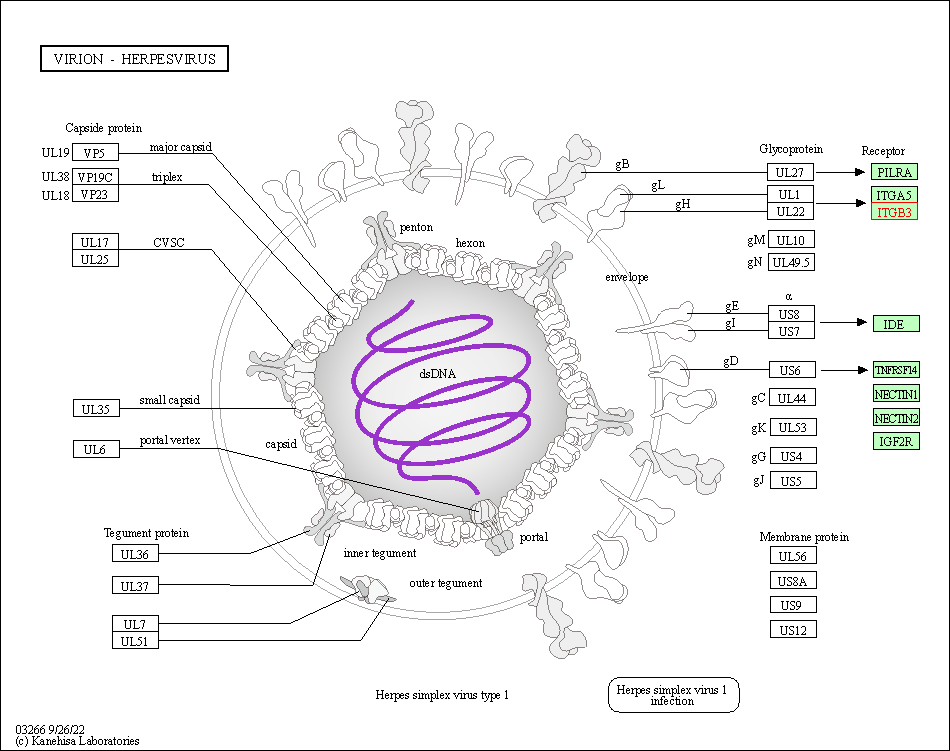
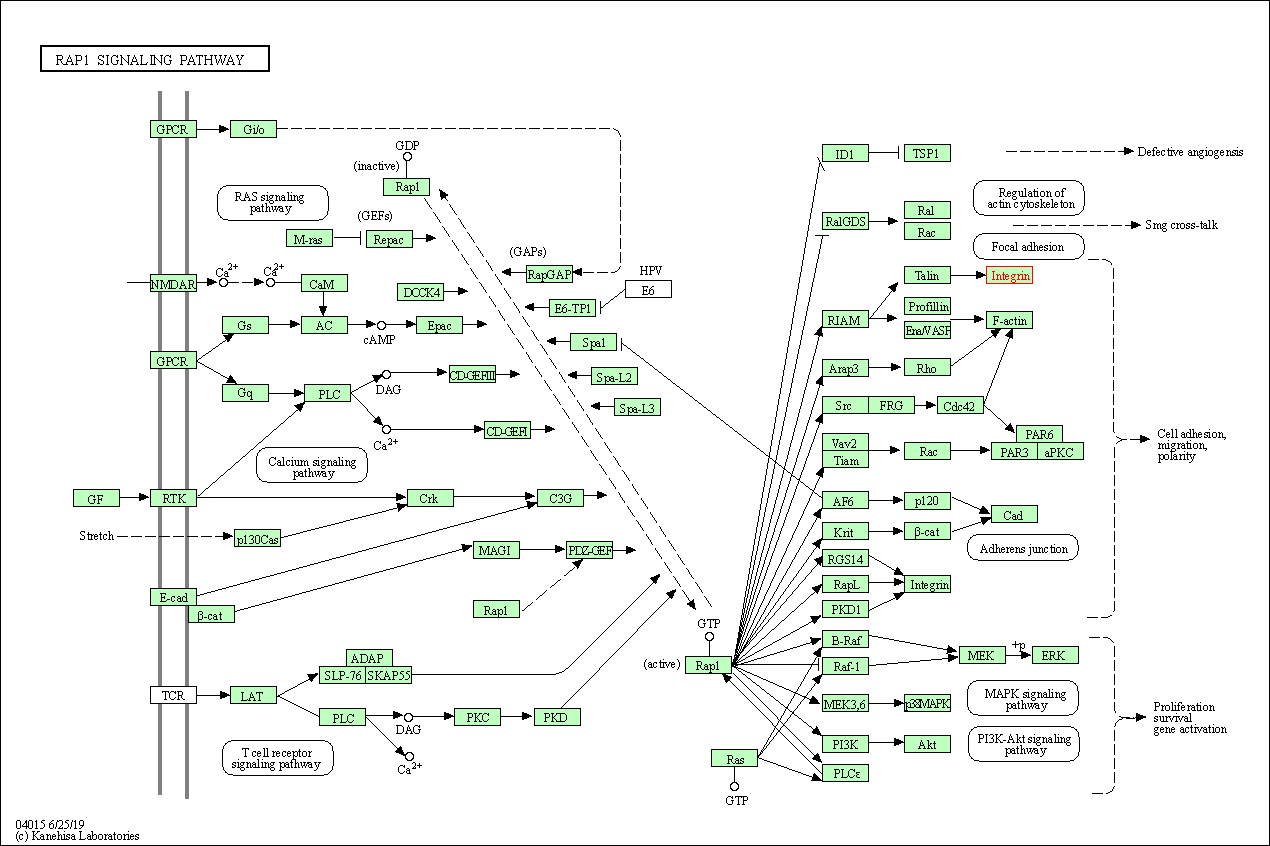
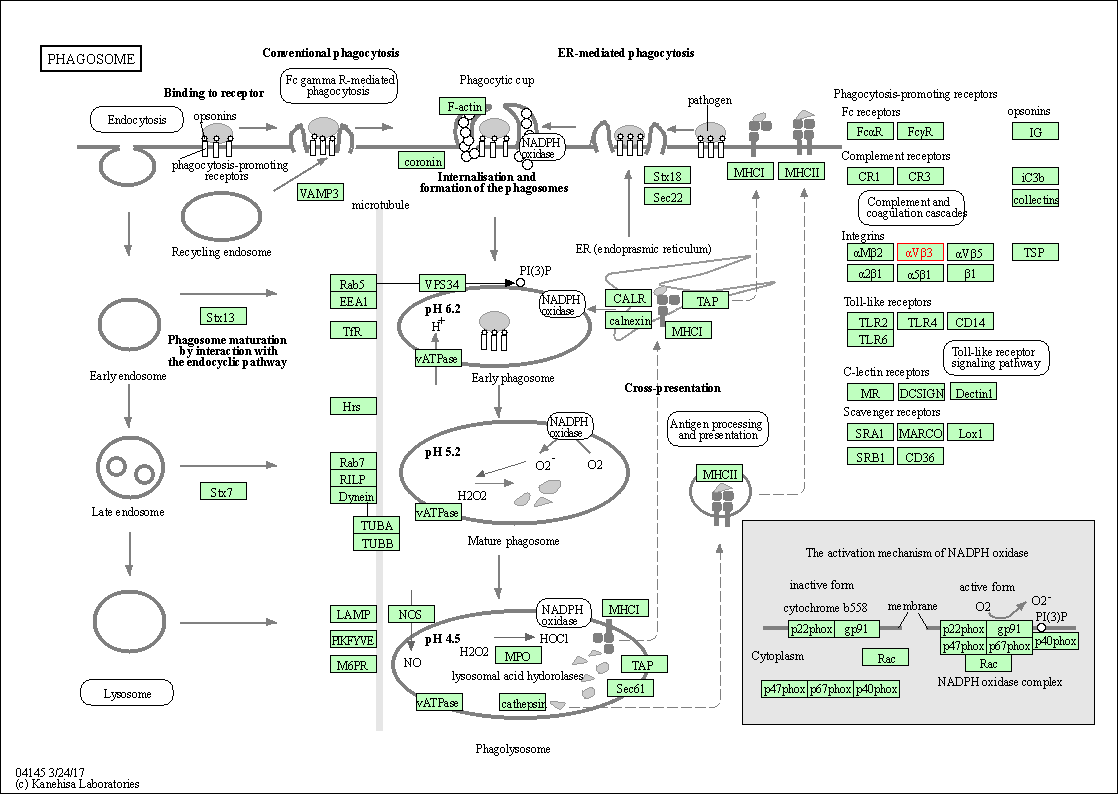
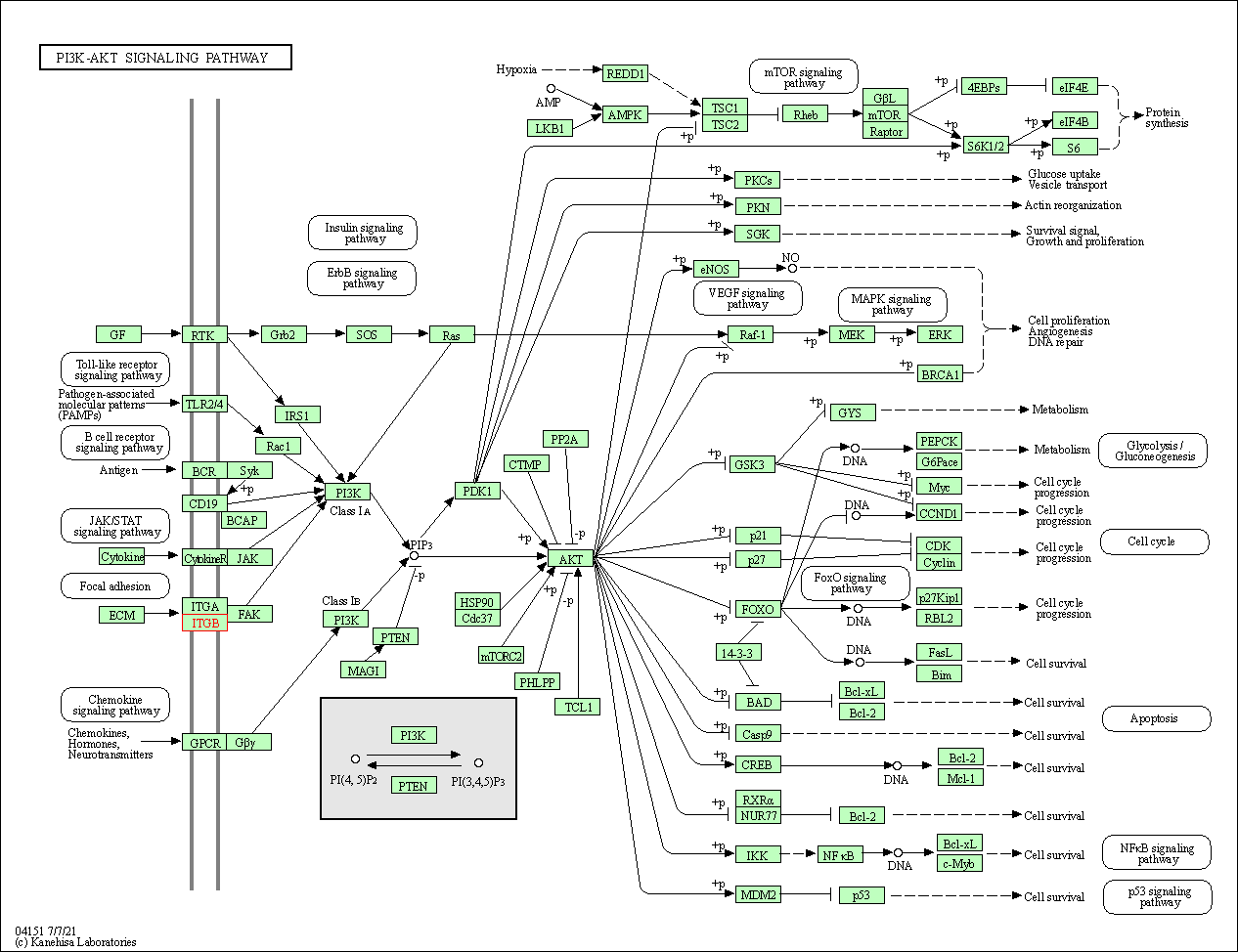
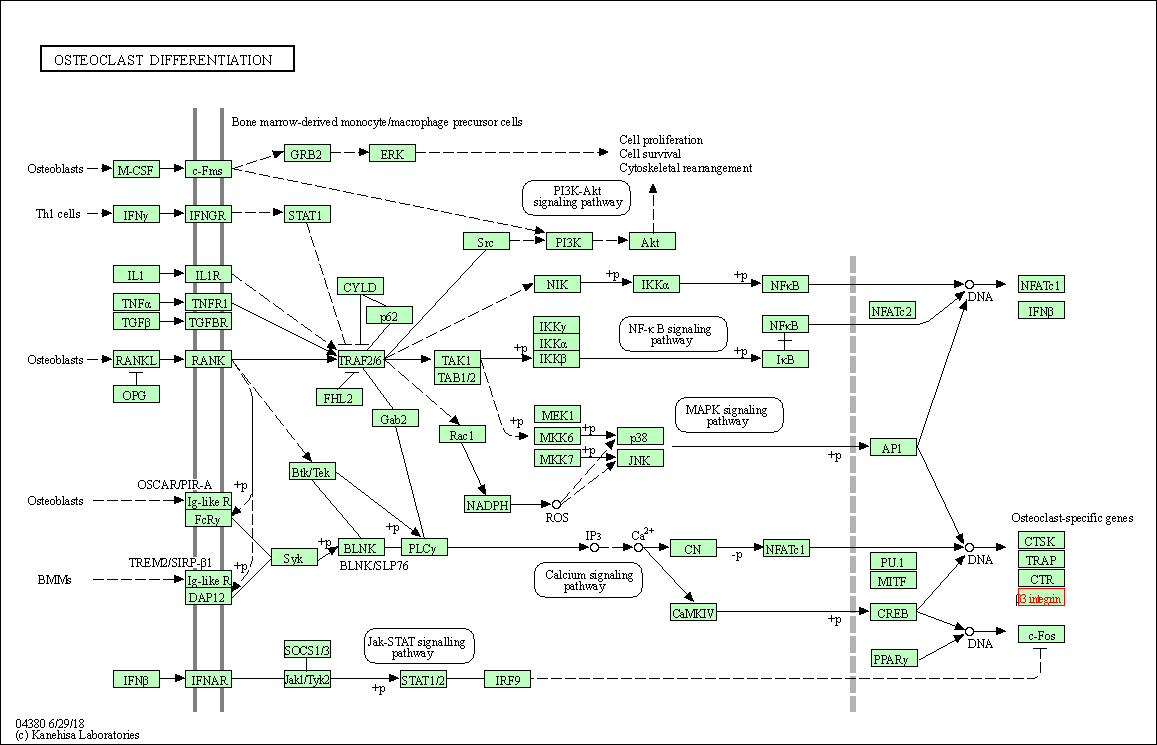


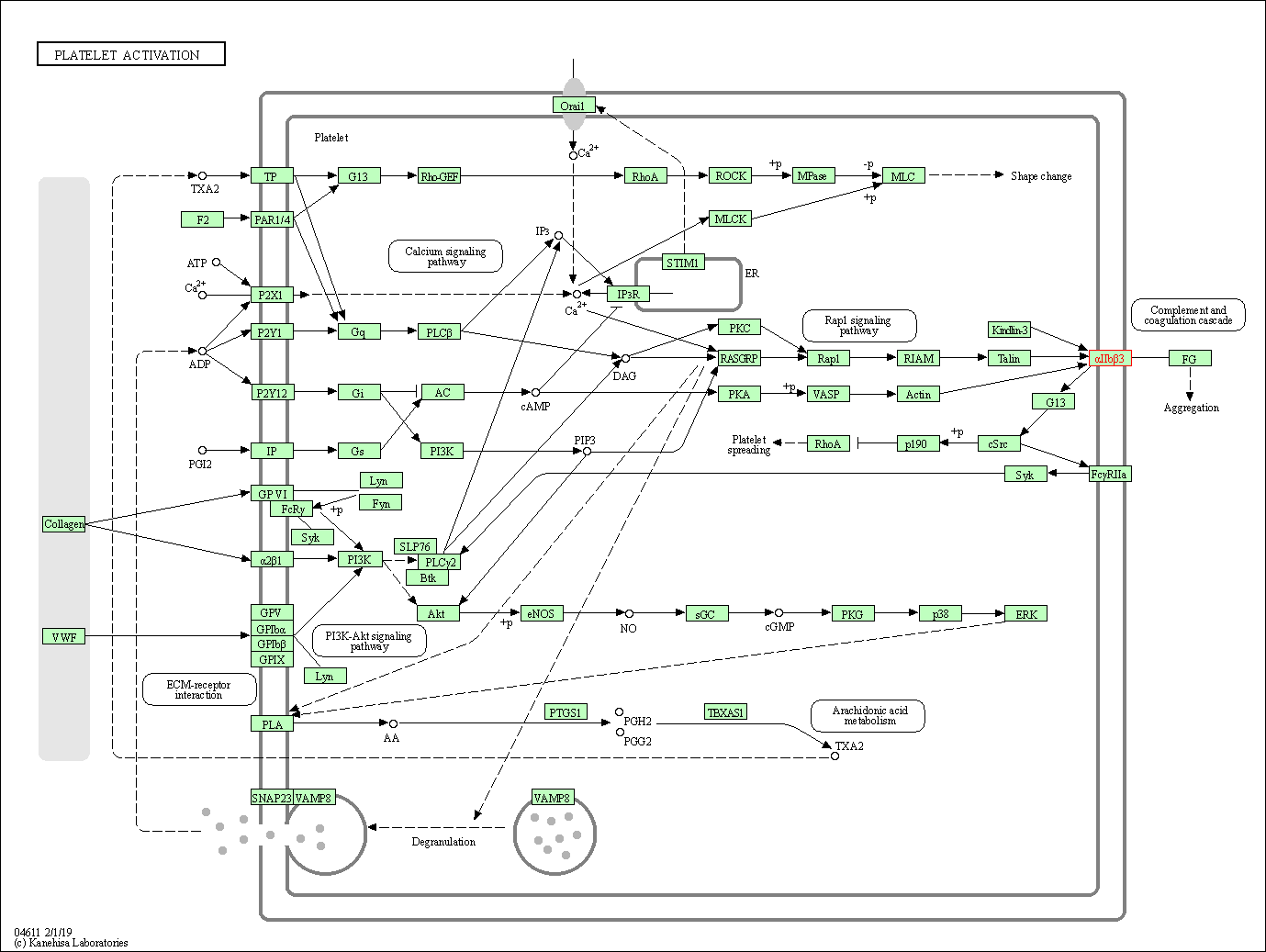
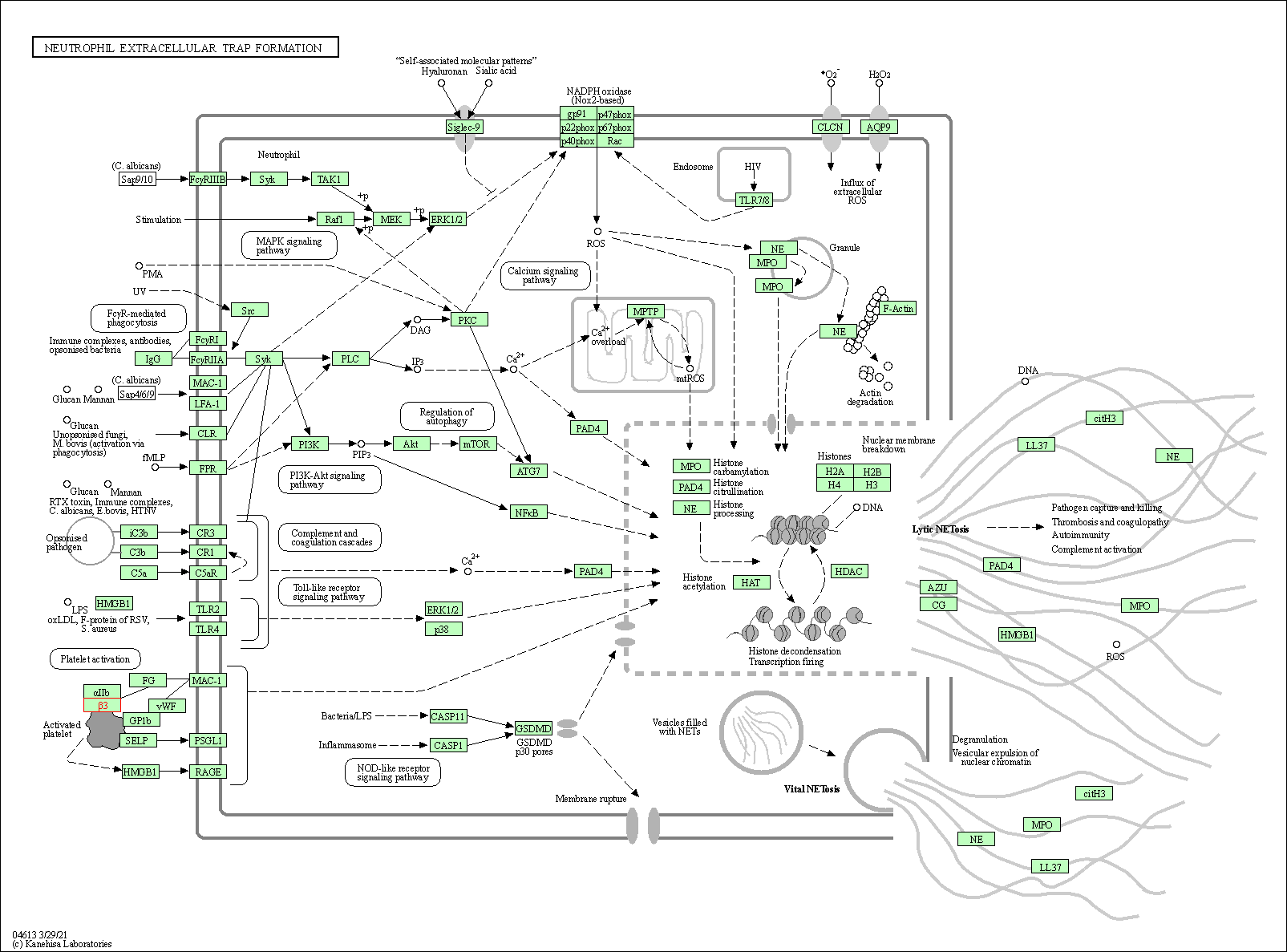


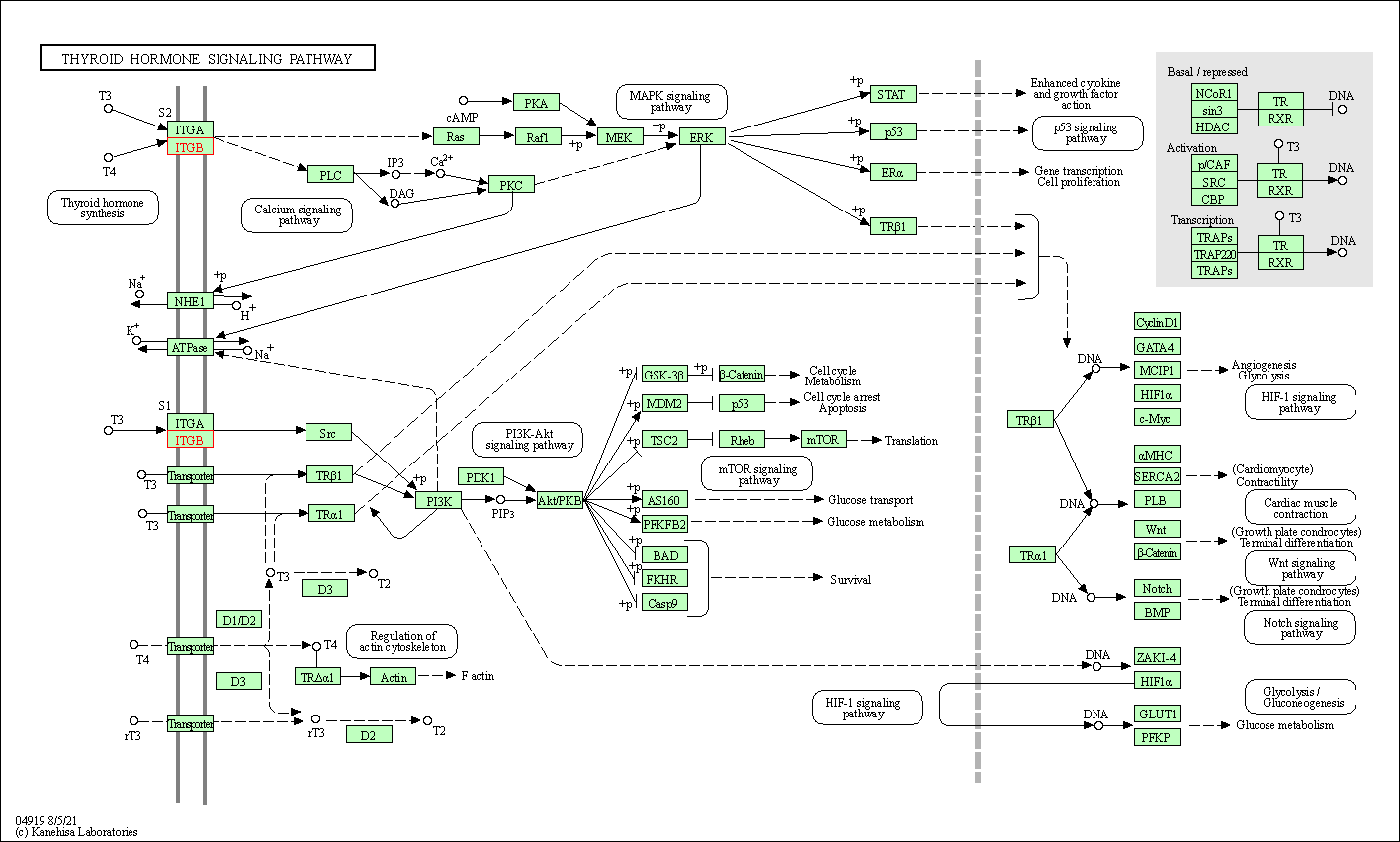
| KEGG Pathway | Pathway ID | Affiliated Target | Pathway Map |
|---|---|---|---|
| Virion - Herpesvirus | hsa03266 | Affiliated Target |

|
| Class: Genetic Information Processing => Information processing in viruses | Pathway Hierarchy | ||
| Rap1 signaling pathway | hsa04015 | Affiliated Target |

|
| Class: Environmental Information Processing => Signal transduction | Pathway Hierarchy | ||
| Phagosome | hsa04145 | Affiliated Target |

|
| Class: Cellular Processes => Transport and catabolism | Pathway Hierarchy | ||
| PI3K-Akt signaling pathway | hsa04151 | Affiliated Target |

|
| Class: Environmental Information Processing => Signal transduction | Pathway Hierarchy | ||
| Osteoclast differentiation | hsa04380 | Affiliated Target |

|
| Class: Organismal Systems => Development and regeneration | Pathway Hierarchy | ||
| Focal adhesion | hsa04510 | Affiliated Target |

|
| Class: Cellular Processes => Cellular community - eukaryotes | Pathway Hierarchy | ||
| ECM-receptor interaction | hsa04512 | Affiliated Target |

|
| Class: Environmental Information Processing => Signaling molecules and interaction | Pathway Hierarchy | ||
| Platelet activation | hsa04611 | Affiliated Target |

|
| Class: Organismal Systems => Immune system | Pathway Hierarchy | ||
| Neutrophil extracellular trap formation | hsa04613 | Affiliated Target |

|
| Class: Organismal Systems => Immune system | Pathway Hierarchy | ||
| Hematopoietic cell lineage | hsa04640 | Affiliated Target |

|
| Class: Organismal Systems => Immune system | Pathway Hierarchy | ||
| Regulation of actin cytoskeleton | hsa04810 | Affiliated Target |

|
| Class: Cellular Processes => Cell motility | Pathway Hierarchy | ||
| Thyroid hormone signaling pathway | hsa04919 | Affiliated Target |

|
| Class: Organismal Systems => Endocrine system | Pathway Hierarchy | ||
| Click to Show/Hide the Information of Affiliated Human Pathways | |||
| Degree | 52 | Degree centrality | 5.59E-03 | Betweenness centrality | 4.35E-03 |
|---|---|---|---|---|---|
| Closeness centrality | 2.53E-01 | Radiality | 1.44E+01 | Clustering coefficient | 8.07E-02 |
| Neighborhood connectivity | 3.27E+01 | Topological coefficient | 3.94E-02 | Eccentricity | 11 |
| Download | Click to Download the Full PPI Network of This Target | ||||
| Target Regulators | Top | |||||
|---|---|---|---|---|---|---|
| Target-regulating microRNAs | ||||||
| Target-interacting Proteins | ||||||
| References | Top | |||||
|---|---|---|---|---|---|---|
| REF 1 | The mammary progenitor marker CD61/beta3 integrin identifies cancer stem cells in mouse models of mammary tumorigenesis. Cancer Res. 2008 Oct 1;68(19):7711-7. | |||||
| REF 2 | A general chemical principle for creating closure-stabilizing integrin inhibitors. Cell. 2022 Sep 15;185(19):3533-3550.e27. | |||||
If You Find Any Error in Data or Bug in Web Service, Please Kindly Report It to Dr. Zhou and Dr. Zhang.

